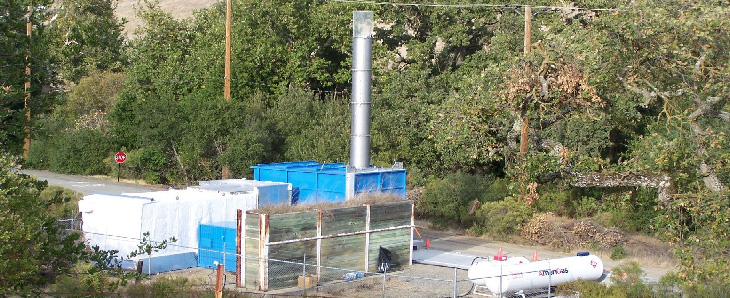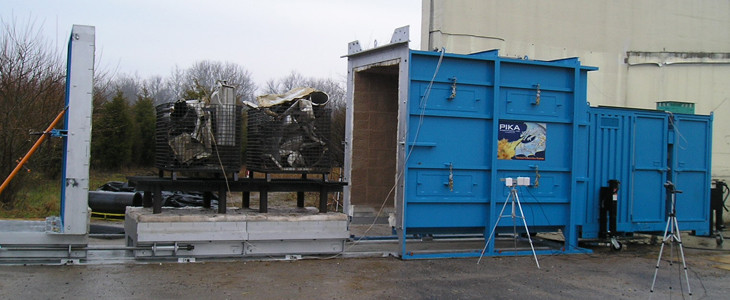The application of PIKA’s remotely operated Thermal Convection System (TCS) significantly reduced the risks associated with the demolition of these energetics-contaminated structures.
Station 0531 of the United Technologies Corporation (UTC)/Pratt & Whitney Rocketdyne (PWR) facility in San Jose, CA was a two-story bunker type structure that housed a specialty 750-gallon single-screw mixer, vacuum, and loading screen/hopper used to combine ingredients for Titan IV space booster (rocket) propellant, Ammonium Perchlorate (AP). As much as 12 million pounds of Titan IV propellant was mixed per year from 1962 until 1996. The client, ARCADIS-BBL Environmental Services (ABBLES), wanted to demolish the heavily contaminated building and equipment, but they could not risk the hazards associated with traditional demolition methods.
To safely render the buildings and equipment safe for conventional demolition, we proposed and implemented the use of our Remote TCS prior to the demolition of the structure to desensitize the building and its contents from explosive hazards. Applying the TCS remotely increased safety by removing personnel from the vicinity of the station, the single-screw mixer, and associated equipment. After onsite contractors removed all visible hazardous materials and drained the pressurized fire suppression lines/oil reservoirs, we designed and assembled an insulated enclosure around the mixer on both the first and second floors. Two TCS Units were positioned to provide uniform/controlled heating of the mixer assemblies, while thermal decontamination was monitored at the remote operation station via real time data feeds and cameras.
The desensitization of the residual energetics in the Station 0531 Mixer was safely accomplished from a remote distance of 2200 feet by heating and maintaining the assemblies to a temperature which exceeded the auto-ignition temperature of the residual AP propellant (475°F). This temperature was maintained for a period of three hours to fully penetrate the motor housing and drive assemblies, mitigating the potential risk of the residual energetics and providing QA/QC confirmation to allow conventional disassembly of the station.
For more complex Stations such as the woodlined Station 0316 nitroglycerin storage magazine, the additional combustibles presented the issue of possible increased emissions during thermal decontamination. To neutralize the explosive residues within the wood, a reduced oxygen burn of the wood was required which would generate smoke from the by-products of incomplete combustion. We designed an Emissions Control Technology (ECT) that directed the exhaust into a secondary combustion chamber and elevated both the temperature and available oxygen to mitigate the smoke and any residual contaminants prior to release. This process was of extreme importance, particularly given the stringent environmental standards present in California.
For more information, please contact us.


